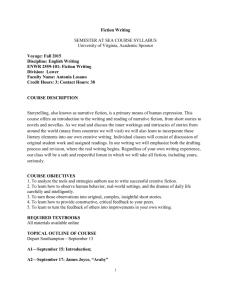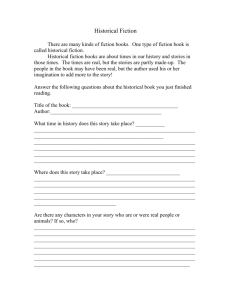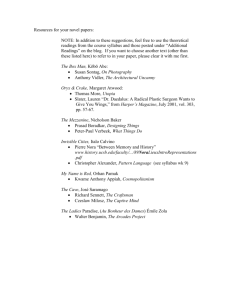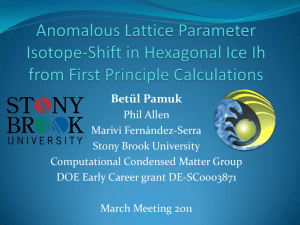Syllabus
advertisement
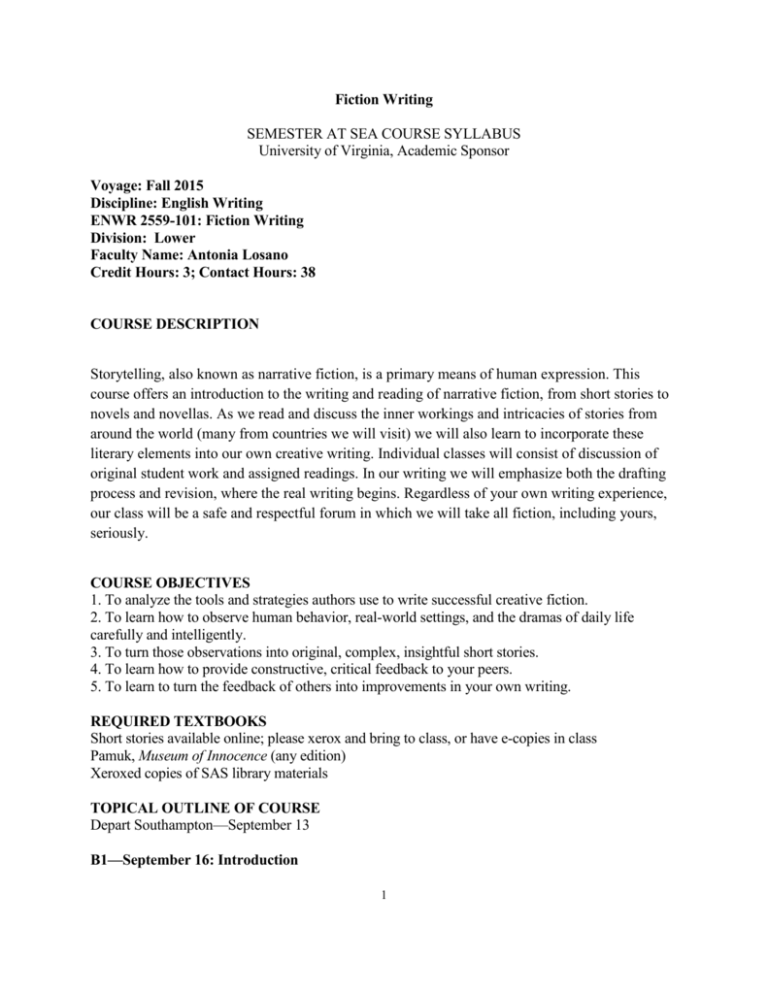
Fiction Writing SEMESTER AT SEA COURSE SYLLABUS University of Virginia, Academic Sponsor Voyage: Fall 2015 Discipline: English Writing ENWR 2559-101: Fiction Writing Division: Lower Faculty Name: Antonia Losano Credit Hours: 3; Contact Hours: 38 COURSE DESCRIPTION Storytelling, also known as narrative fiction, is a primary means of human expression. This course offers an introduction to the writing and reading of narrative fiction, from short stories to novels and novellas. As we read and discuss the inner workings and intricacies of stories from around the world (many from countries we will visit) we will also learn to incorporate these literary elements into our own creative writing. Individual classes will consist of discussion of original student work and assigned readings. In our writing we will emphasize both the drafting process and revision, where the real writing begins. Regardless of your own writing experience, our class will be a safe and respectful forum in which we will take all fiction, including yours, seriously. COURSE OBJECTIVES 1. To analyze the tools and strategies authors use to write successful creative fiction. 2. To learn how to observe human behavior, real-world settings, and the dramas of daily life carefully and intelligently. 3. To turn those observations into original, complex, insightful short stories. 4. To learn how to provide constructive, critical feedback to your peers. 5. To learn to turn the feedback of others into improvements in your own writing. REQUIRED TEXTBOOKS Short stories available online; please xerox and bring to class, or have e-copies in class Pamuk, Museum of Innocence (any edition) Xeroxed copies of SAS library materials TOPICAL OUTLINE OF COURSE Depart Southampton—September 13 B1—September 16: Introduction 1 B2—September 18: James Joyce, “Araby” Civitavecchia—September 19-22 Naples—September 23-24 B3—September 26: Pamuk, Museum of Innocence, first half B4—September 28: Pamuk, Museum of Innocence, second half Istanbul—September 29-October 3 B5—October 5: Draft Story #1 due: Writing Workshop Piraeus—October 6-10 B6—October 12: Hemingway, “Clean, Well-Lighted Place” B7—October 14: Hemingway, “Hills like White Elephants”; Story #1 due Valencia—October 15-16 Barcelona—October 17-19 B8—October 21: Mohamed Mrabet, “Canebrake” (in Halpern, ed.) Casablanca—October 22-26 B9—October 28: Fatou Diome, selections from The Belly of the Atlantic (handout) B10—October 30: Draft of Story #2 due; Writing Workshop Dakar—October 31-November 3 B11—November 5: Clarice Lispector, “Love” (in Fuentes and Ortega, eds) B12—November 8: Jorge Amado, “How Porincula the Mulatto…” B13—November 10: Draft of Story #2 Due; Writing Workshop Salvador—November 11-16 B14—November 18: E. Danticat, “Night Women” B15—November 20: Story #2 Due; Writing Workshop B16—November 23: Kincaid, “Girl” 2 B17—November 25: V.S. Naipaul, “Raffle” Port of Spain—November 26-27 B18—November 29: Octavio Paz, “My life with the Wave” B19—December 1: Carmen Lyra TBA B20—December 4: Outline Story #3 Due; Writing Workshop Puntarenas—December 5-9 B21—December 11: Carver, “Cathedral” B22—December 13: Draft Story #3 due; Writing Workshop B23—December 15: Story Presentations B24—December 18: A-Day Finals; Story #3 Due Arrive San Diego—December 21 FIELD WORK Field lab attendance is mandatory for all students enrolled in this course. Do not book individual travel plans or a Semester at Sea sponsored trip on the day of your field lab. FIELD LAB (At least 20 percent of the contact hours for each course, to be led by the instructor.) While in Istanbul we will work on two writing projects: first, a story which has at its core some seemingly trivial object, which nevertheless has a profound tale to tell, and second, a dialogue-based story. We will have read portions of Turkish writer Pamuk’s Museum of Innocence, a novel structured around a series of meaningful objects the protagonist enshrines to his beloved. Pamuk created an actual “Museum of Innocence” in Istanbul, which houses a series of everyday objects which are profoundly meaningful for Turkish history and culture. We will visit his museum, and discuss what kinds of objects we might choose to use for our own stories. After lunch, we will travel across the Golden Horn to the Topkapi Palace and tour the Harem rooms, spaces also filled with everyday objects which are now deeply meaningful. After our tour, we will adjourn to the nearby Gulhane Park for an outdoor writing exercise. FIELD ASSIGNMENTS After our required Field Lab, you will be asked to prepare a brief class presentation on a story idea generated during that Lab. That presentation will become the basis for your first short story, due November 7th. 3 During all port stops, you should be attuned to potential source material for stories. You will be asked to write 1-2 page journal entries after 5 port stops of your choice on 5 topics: character description; dialogue exchange; setting description; plot/action/scene; point of view. METHODS OF EVALUATION / GRADING RUBRIC 10% Class participation (active discussion; keeping up with readings; attendance, performance in writing workshops) 10% Response papers (on course readings) and journal entries (5 from port stops of your choice) 20% Field Lab and report 60% Three Stories (includes drafts and revisions) ELECTRONIC COURSE MATERIALS NOTE TO LIBRARIANS: Some course readings are available online on in the SAS stacks collection. Below is a list; could these stories be somehow scanned and put in the electronic course folder? 1. James Joyce, “Araby” http://www.dpcdsb.org/NR/rdonlyres/F6177888-9FFF-429A-A76BE3D50A131CAC/123475/Araby.pdf 2. Pamuk, Museum of Innocence (any edition) 3. Short (Two Sentence) Fiction: http://www.salon.com/2013/12/25/two_sentence_holiday_fiction_amazing_short_short_storie s_from_amazing_writers/ 4. Clarice Lispector, “Love”, in Fuentes and Ortego, eds. Latin American Short Stories (SAS library) 5. Mohamed Mrabet, “Canebrake” in Halpern, ed. The Art of the Story (in the SAS library) 6. V.S. Naipaul, “Raffle” in Loughery, ed. Into the Widening World (in the SAS library) Each faculty member will have an electronic course folder housed on the ship’s intranet. The University of Virginia library will scan articles and chapters identified by the faculty member as needed supplementary materials for the courses they are teaching. These materials will be placed in the faculty member’s intranet folder for students to access. PLEASE NOTE: Materials that may be scanned for a course without obtaining copyright 4 permissions include one chapter from a book; one article from a journal issue; government publications; anything for which you own the copyright; or anything in the public domain. If you wish to go outside of these guidelines, you will need to seek copyright permission from the publisher of the journal or book. AUTHOR: ARTICLE/CHAPTER TITLE: JOURNAL/BOOK TITLE: VOLUME: DATE: PAGES: ADDITIONAL RESOURCES Do you anticipate that students will be expected to locate and employ resources beyond required texts, reserve library readings, DVDs, or intranet resources? If yes, please identify these resources. HONOR CODE Semester at Sea students enroll in an academic program administered by the University of Virginia, and thus bind themselves to the University’s honor code. The code prohibits all acts of lying, cheating, and stealing. Please consult the Voyager’s Handbook for further explanation of what constitutes an honor offense. Each written assignment for this course must be pledged by the student as follows: “On my honor as a student, I pledge that I have neither given nor received aid on this assignment.” The pledge must be signed, or, in the case of an electronic file, signed “[signed].” 5
